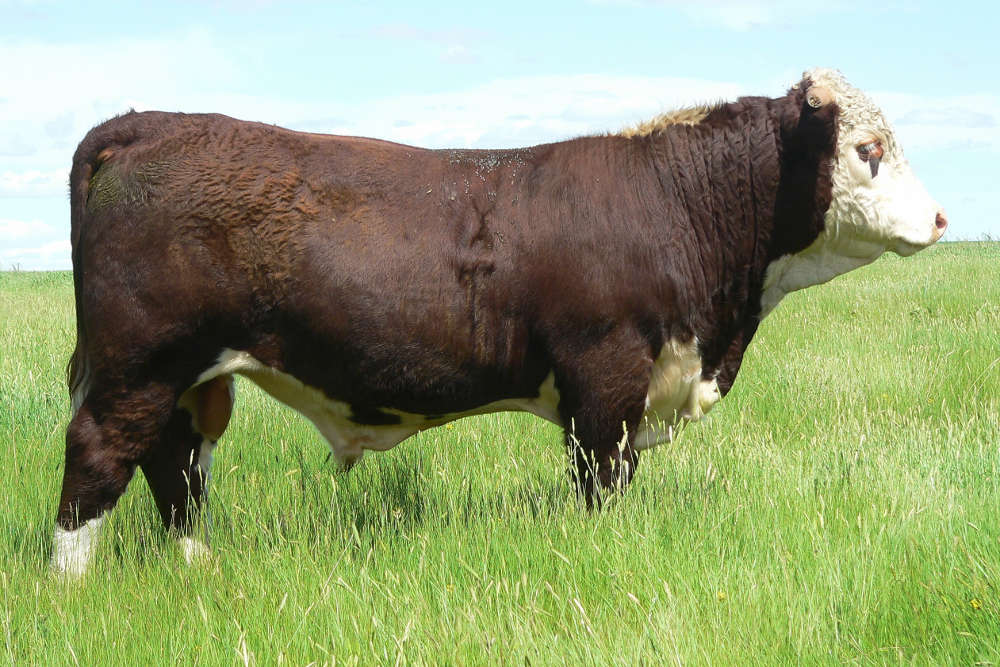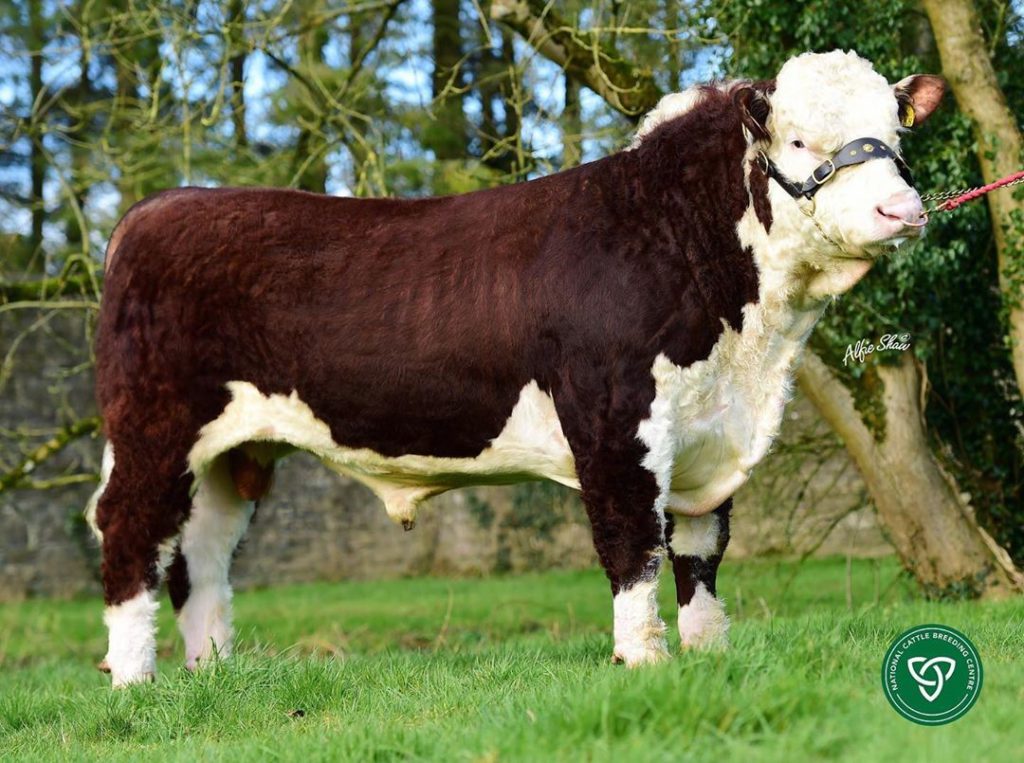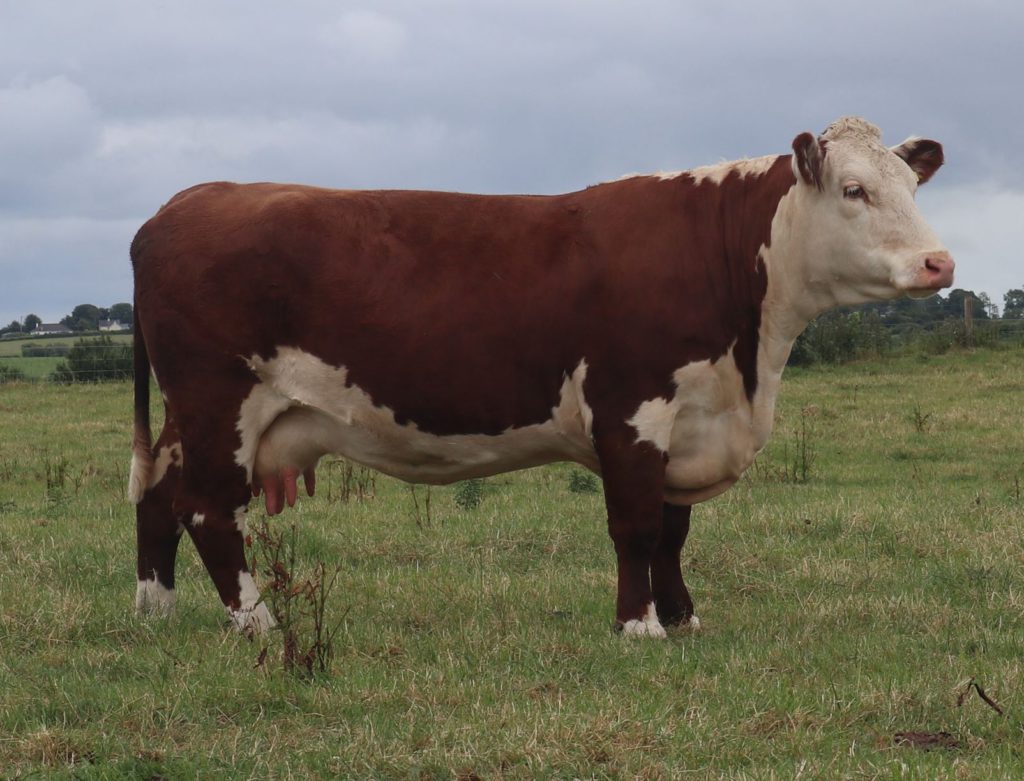In this week’s Suckler Farmer Focus, That’s Farming, speaks to Liam Philpott and Anne Pounds of Allowdale Herefords in Kanturk, Co Cork. They discuss how they grew their horned and polled herd from humble beginnings, the challenges they face and what lays ahead in the future.
The husband-and-wife team farm full time with horned and polled Hereford cattle on their 180-ac operation that has been in the family for many generations.
Liam’s grandfather was a beef farmer and butcher as was Liam’s father. “We had sheep from 1989 to 2010. But cattle are easier to manage,” Anne told That’s Farming.
“As a kid, Liam used to rear bucket-fed calves and progressed into sheep. We specifically decided to breed Herefords coming from a butchering background and recognising the quality of the beef from a Hereford crossed with dairy cattle.”
“The horned Herefords have the prefix Allowdale. We have requested one for the polled Herefords – Allowdale P 1 (the incremental P and 1 are to differentiate the polled Herefords be they homozygous polled or heterozygous polled) – which has not yet been processed.”
“We definitely believe there are significant differences between horned Herefords and polled Herefords. They are almost like two different breeds, and the most noticeable difference in trait is temperament.”
“We have found the horned Herefords to be more docile. The very top end of the polled Herefords have excellent carcass shape. It is noticeable that the ‘show winners’ tend to be polled Herefords.”
“However, the lesser quality polled Herefords we have noticed can be quite poor. In general, there is more consistency with the horned Hereford.” Liam explained.

Allowdale Herefords
In terms of finishing, the breeders have found that the horned Hereford are softer. Therefore, they require fewer inputs than polled Herefords.
They believe there is no doubting that the very top polled Herefords are excellent and worldwide, the Hereford industry is tending towards polled Herefords.
The breeders are working towards establishing polled Hereford lines. They are using genomics to identify homozygous polled Hereford progeny from their best horned Hereford cow families.
Furthermore, they are aiming towards a split of 50/50 horned/polled Hereford suckler herd.
They have roughly 100 suckler cows, all verified pedigree and/or progeny of existing entries in an EU-recognised herd book under the 2016/1012 Animal Breeding Regulation.
UK influence
Some of their most influential cow families originate from the UK.
“We researched all the top herds in the UK and selected upon visual inspection from the list of performance analysis of these herds.
“In fact, when we visited one of the top herds, the breeders stated that we knew their herd better than they did due to the analysis of the performance information that we undertook in advance of the visual selection,” Anne said.
“The initial selection of GH Rambo 279R embryos from Canada, which have been tremendously successful for us, was with the welcome assistance of XTC Herefords who also imported embryos from us in Ireland.
“Their resulting embryos are now one of the 124 trait leaders in Canada. We were very fortunate to deal with genuine and helpful breeders in Canada and the USA,” Anne added.

Breeding programme
The breeding programme is made up of a combination of AI and stock bull use. The present stock bull is [HE4292] Allowdale Rory 594 {HYF} who is the progeny of [F228] Border Rory D35 {HYC}.
“We have made and acquired Canadian and American embryos. They have resulted in two Canadian outcross bulls sold to AI [ HE2027] Allowdale Rambo ET {HYF} with a replacement value of €99 and a dairy beef value of €69 in the most recent November 2021 evaluations,” Anne continued.
“His son [HE4344] Allowdale Rambo 475 {HYF}, is a trait leader with a replacement value of €171, a terminal value of €73 and a dairy beef value of €27 in the most recent November 2021 evaluations.”
Another Canadian outcross is [HE4291] Allowdale Advance 573 ET {HYF} with a replacement value of €75, a terminal value of €51 and a dairy-beef value of €39 in the most recent November evaluations.

Calving
According to Liam, the major concentration of calving is in July, August, and September to ensure that they have bulls ready for customers at 18 months. The farming couple sells all their cattle as purebred genotyped pedigreed.
The majority of their customers for bulls are dairy farmers. Hence the focus of short gestation, easy calving in addition to not compromising carcass traits.
The best customers are those that keep their calves until 18 months. They can see the true benefit of using a high-quality Hereford bull.
The couple believes there could be 50 kg of a difference at 18 months between the dairy farmer using a high quality versus low-quality bull – a significant difference in profit for the dairy farmer.
“There is a domestic and international market for high-end heifers; the prices can vary depending on the heifer. There is an export market for the rest, while the poorer cattle should be slaughtered.”
“The (EU )2016/1012 Animal Breeding Regulation will greatly assist the trade in purebred breeding animals and germinal products owing to the uniformity of the EU zootechnical certificates which will also encourage trade in germinal products such as semen, embryos and oocytes,” Anne explained.
Ideal cow-type
The ideal cow-type is 650-750kg, docile with “lots” of milk.
“Performance recording is an important facet of our herd management with weight recording and linear scoring with the inclusion of weaning and yearling weights in a timely manner.
“Such information, we believe, is vital in discerning and sorting outperformers from non-performers. Therefore, a strict culling policy is in place to weed out lack of milk, oversized teats, prolapses, bad feet and consistent under-performers.
“We believe the Hereford breed is currently in a good position with easy calving, short gestation, and good temperament.
“Joining the Whole Herd Performance Recording, BEEP-S and Greenbreed programmes enable us to obtain the parameters to assess performance across the entire herd,” Liam said.

Culling policy and calving heifers at 24 months
The breeders cull 20% of the herd every year to make way for the next generation, retaining a select 20% of the heifers based on quality and keeping cow families going.
These heifers, Anne & Liam said, aim to calve down at 2 years at approximately 600 kgs. They have found that by the time the heifers get to 30 months, they can be too fat, resulting in calving difficulty and their milk is compromised.
The breeders have noticed that the older, more mature heifers do not last in the herd as long.
The couple does not retain poor quality progeny for breeding and bring these through to slaughter. They kill inferior male progeny as bulls under 2 years of age. They are typically 320 to 340kgs (carcass) and usually make R grades, with a fat score of 3 to 4.
Also, they slaughter females unsuitable for breeding at 18 months through the Hereford Prime Schemes. At 18 months, heifers typically have carcass weights of 260 to 270 kg, grade Rs, and have a fat score of 3 to 4.
The policy is for one calf per cow per year. However, very good cows will get a pass if there is a delay in getting in-calf. Allowdale Herefords does not sell any cattle in marts.
Grassland management
Liam and Anne use a paddock grazing system for their cattle.
Grassland management is very important but probably not as important as genetics. Anne and Liam believe that Hereford breeders are more than likely the only beef farmers who are constantly trying to slim cattle down.
It is a paradox of the breed. Their greatest attribute, easy-fleshing on low inputs, can also be their biggest weakness, as the dry cows can become very fat on what seems like no grass at all.
The breeders have to stock cows on very tight grazing to calve them in the summer months. The young stock are rotationally grazed to optimise their performance on grass.
ICBF monitors this through the Whole Herd Performance Recording along with BEEP where all the young stock are weighed. The breeders aim to have at least 3 weights per animal recorded by ICBF in January and June each year.

High points
Liam and Anne have many high points to reflect on, with the following bulls standing in AI:
- HE4344 Allowdale Rambo 475 {HYF} (Progressive Genetics)
#1 of the Hereford breed in the November 2021 – ICBF Replacement Index Ranking.
#2 of the Hereford breed in the November 2021 – ICBF Terminal Index Ranking.
- HE5452 Allowdale Rory 835 (Progressive Genetics)
#2 of the Hereford breed in the November 2021 – ICBF Dairy Beef Index (DBI).
#3 of the Hereford breed in the November 2021 – ICBF Terminal Index Ranking.
- HE5298 Allowdale Rambo 738 {HYF} (Progressive Genetics)
#3 of the Hereford breed in the November 2021 – ICBF Replacement Index Ranking.
Liam and Anne enjoy the docility of the Hereford breed. They believe their success lies in their attention to detail and their ability to secure repeat customers.
One of the biggest challenges the couple had to overcome was getting established and recognised for their joint capacity in identifying, selecting, and breeding top quality genetics.
Current challenges they face include promoting the breed within the EU as well as exporting to countries within the EU.
Future plans
Looking forward, the couple would like to improve on their polled Herefords. As for suckler farming as a whole, they believe that low-input breeds have a promising future.
As participants in the Beef Data and Genomics Programme (BDGP) have SNP genotyped all their breeding animals from 2014 onwards. Hence most animals have three generations of genotype information recorded.
“We hope that our early adoption of technology will work well with the programme. We also participate in the Bord Bia Sustainable Quality Assurance Scheme and hope this will also prove beneficial,” said Anne.
She also shared her view on the prices achieved for quality progeny.
“I believe, the market is in flux at the moment, with commercial sucklers achieving higher prices than average pedigree prices. Furthermore, the prices of the pedigree show ring (cattle) are not based on performance or evaluations.
“We are focused on producing quality cattle and selling at the correct market price.
“Also, we are very proud of our selection of worldwide genetics and our success outside of the show ring. We have repeat customers that know they can obtain proven genetics.”

More commercial basis
Liam said that the breeders do not believe in the show ring as a means of improving the herd.
They prefer to run the horned and polled Hereford herds on a more commercial basis without the additional grooming, feeding and preparation being a show exhibitor requires.
“All Hereford cattle (polled and horned) are group managed with none getting preferential treatment.”
“It is only by having equal treatment that you can assess through performance that will translate into commercially focused farms and farmers that the breeders sell to.”
To share your story like Allowdale Herefords, email Catherina Cunnane, editor of That’s Farming, – [email protected]
See more suckler farmer articles.





